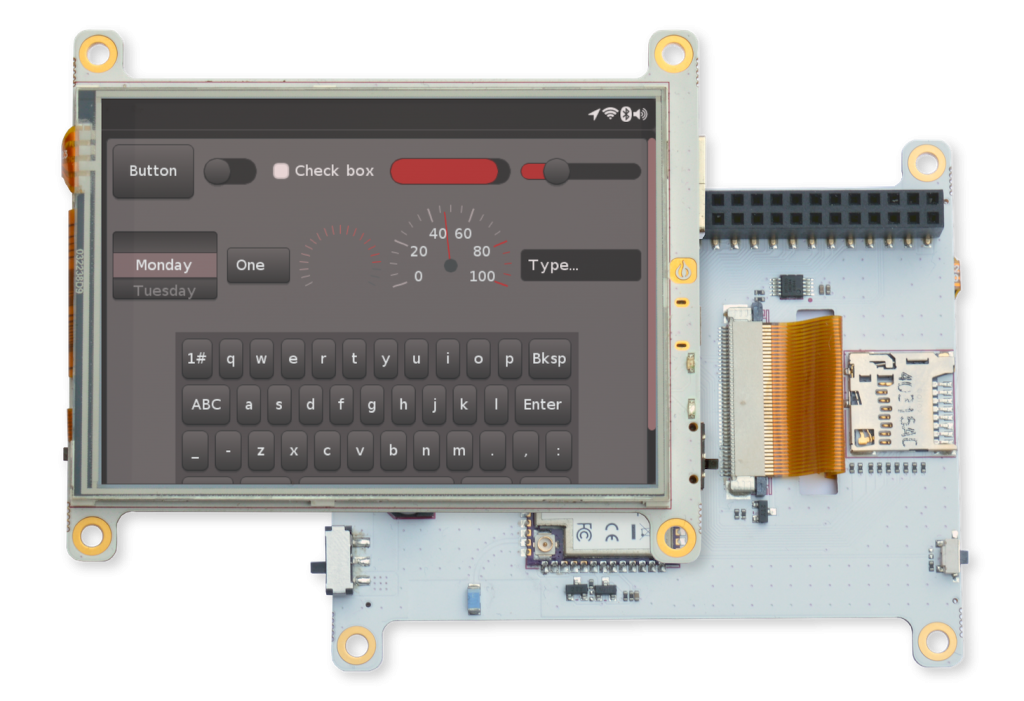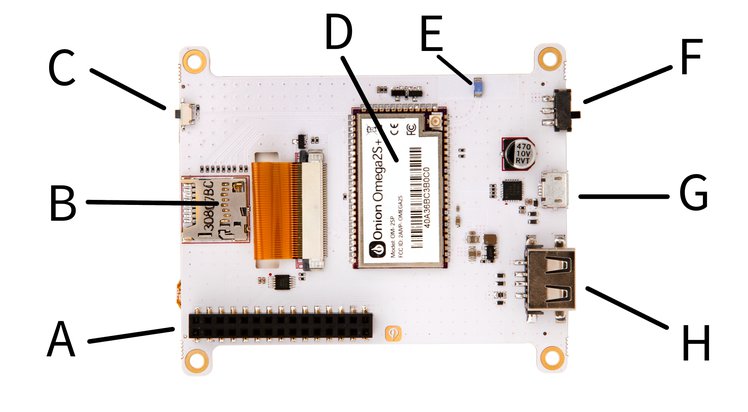Menu
Touchscreen and WiFi-enabled Linux single board computer
The Omega2 Dash is a Wi-Fi-enabled Linux computer with a built-in touchscreen. It is a stand-alone, all-in-one solution for developing touch-based graphical user interfaces that can be internet-connected, connected to other devices, or both.
- 3.2" TFT touchscreen display for creating embedded GUIs
- Hardware design and OS are open source
- Dual mode 2.4 GHz 802.11 b/g/n Wi-Fi - simultaneously host a WiFi access point and connect to existing WiFi networks
- CPU, memory, and storage are built-in
- Runs OpenWRT Linux operating system out of the box
- Features USB, ethernet, 2x UARTs, I2C, GPIOs interfaces
- Easy command line access through MicroUSB Port

Overview
The Omega2 Dash is a Wi-Fi enabled Linux computer with a built-in touchscreen. It is a stand-alone, all-in-one solution for developing touch-based graphical user interfaces that can be internet-connected, connected to other devices, or both.
Combining a 3.2″ TFT touchscreen display with an Omega2S+ module, the Omega2 Dash enables quick and easy development of physical user interfaces. Users are able to create interactive graphical user interface (GUI) applications for their connected, edge-computing applications – either for initial development or deployment as part of an end-device. The hardware design is open-source, so it can serve as a reference design for using the Omega2S modules with TFT displays in the former case.
Touchscreen Display
With a 3.2″ TFT touchscreen display, the Omega2 Dash brings touchscreen capability to the established Omega2 Linux computer platform. The display resolution is 320×240, supports 16-bit color, and is rated for over 50,000 hours of operation under normal conditions. The resistive touch input is 12-bit, providing excellent accuracy, and is interfaced over I2C. On the software side, developers can easily interact with the display device through the Linux framebuffer. This significantly reduces the time and complexity of creating a GUI IoT application since the nitty-gritty details of controlling the display are handled behind the scenes by the Linux OS. To get started quickly, developers can use the command line tools to write text or even move the command prompt and output to the display. To enable the creation of GUIs meant for real-world use, the Omega2 Dash was designed to be compatible with the LVGL, an open-source graphics library with easy-to-use graphical elements and visual effects for building embedded GUIs. Developers can use the LVGL library in C and C++ programs or with MicroPython. With both options, the library will simplify GUI rendering and handling touch input, allowing developers to focus on their business logic.Hardware
The Omega2 Dash hardware was designed to make it easy to develop embedded GUIs:- Extensive I/O
- MicroUSB port for power and command-line access
- Physical USB port for easy connectivity of other devices
- Features 4 mounting holes for easy placement with a mount or an enclosure
- Dev friendly power switch, reset button, and status LEDs
- Very small – measuring only 82 x 70 mm, making it slightly larger than the 3.2″ display
Software
The Omega2 Dash runs an Onion-customized version of OpenWRT Linux, based on the modern 4.14 Linux kernel. Users can rely on the Linux system to abstract away complexity in device operation and on the networking and cryptography stack to simplify connectivity. The OS is open-source and available on GitHub, allowing users to customize it to meet their individual needs. By virtue of the Linux OS, developers are not limited in their choice of programming language. Supported programming languages include:- Python3
- NodeJS 8.10
- GoLang
- Rust
- Ruby
- C and C++
- Shell
- PHP
- Perl
Specifications
- 3.2″ TFT touchscreen display
- 320×240 resolution
- 16-bit (RGB565) color support
- 12-bit resistive touch input
- Rated at minimum MTBF value of 50,000 hours with normal operation
- Based on the Omega2S+ IoT computer module
- Processor: 580 MHz MIPS CPU
- Memory: 128 MB RAM
- Storage: 32 MB
- Connectivity: 2.4 GHz b/g/n Wi-Fi (access point & client)
- Operating System: OpenWrt 18.06 Linux
- I/O
- Expansion Header
- I²C, UART, PWM, Ethernet, GPIOs
- Compatible with existing ecosystem of Omega2 Expansions
- USB 2.0 host
- MicroSD card slot
- Expansion Header
- Antenna
- 2 dBi directional chip antenna
- U.FL connector for external antenna
- USB-to-serial interface on Micro USB port
- Provides reliable, always-on access to the Omega’s commandline
- Status LEDS
- Amber: Indicates whether Linux OS has booted
- Off – Device not powered on
- Blinking – Booting/updating
- On – Up and running
- Blue: Indicates connection to a Wi-Fi network
- Off – Not connected to a Wi-Fi network
- Blinking – Connecting
- On – Connected
- Amber: Indicates whether Linux OS has booted
- Weight: 60 g
- Dimensions: 82 mm x 70 mm

A. 30-pin Expansion Header
B. MicroSD card slot
C. Reset button
D. Omega2S+ IoT module
E. Chip antenna
F. On/off switch
G. Micro USB portH. USB 2.0 host port

I. 3.2″ TFT touchscreen
J. Holes for easy mounting
K. Amber System Status LED
L. Blue Wi-Fi Status LED
Documentation & resources
Frequently asked questions
Find a list of Onion distributors HERE
Fill out the form here and our sales team will get back to you with volume pricing info and more.
See our volume ordering page for all of the details.
